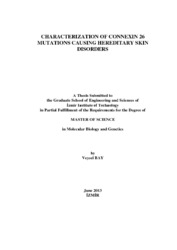Please use this identifier to cite or link to this item:
https://hdl.handle.net/11147/3622Full metadata record
| DC Field | Value | Language |
|---|---|---|
| dc.contributor.advisor | Meşe Özçivici, Gülistan | - |
| dc.contributor.author | Bay, Veysel | - |
| dc.date.accessioned | 2014-07-22T13:51:58Z | - |
| dc.date.available | 2014-07-22T13:51:58Z | - |
| dc.date.issued | 2013-06 | - |
| dc.identifier.uri | http://hdl.handle.net/11147/3622 | - |
| dc.description | Thesis (Master)--Izmir Institute of Technology, Molecular Biology and Genetics, Izmir, 2013 | en_US |
| dc.description | Includes bibliographical references (leaves: 39-42) | en_US |
| dc.description | Text in English; Abstract: Turkish and English | en_US |
| dc.description | ix, 42 leaves | en_US |
| dc.description | Full text release delayed at author's request until 2016.08.13 | en_US |
| dc.description.abstract | Connexins (Cx) are building blocks of gap junctions that provide intercellular communication between adjacent cells. There exist 21 types of connexins in human body which are important for human physiology. Hence, in any case of deficiency or mutation, disorders can occur. For instance, most of the characterized Cx26 mutations are related to deafness; while there are few mutations associated with different skin disorders. One of them is a rare congenital skin disorder; Keratitis- Ichthyosis-Deafness (KID) syndrome. In this study, we aimed to investigate the effects of Cx26 mutations associated with KID syndrome in two gap junctional communication-deficient cell lines; mouse neuroblastoma (N2A) and human cervix carcinoma (HeLa), and also in human keratinocytes (HaCaT). For this purpose, newly identified KID syndrome mutations, A88V, D50A, D50Y, and I30N were characterized. Studies on N2A cells demonstrated that Cx26 mRNA levels of mutants were higher than Cx26 WT, whereas their protein expression were very low compared to Cx26 WT. Moreover, in HeLa cells, mutant proteins were observed to be localized mainly in the cytoplasm. Furthermore, the uptake of fluorescent dyes into the cells through the mutant hemichannels was statistically higher than Cx26 WT hemichannels. For HaCaT cells, mutant proteins did not have any effect on Keratin 10 expression, a marker for suprabasal layers of epidermis. In conclusion, all four mutations caused increased hemichannel activity similar to other analyzed KID syndrome mutations, which provides a further support for the presence of increased hemichannel activity as a mechanism for mutations leading to KID syndrome. | en_US |
| dc.language.iso | en | en_US |
| dc.publisher | Izmir Institute of Technology | en_US |
| dc.rights | info:eu-repo/semantics/openAccess | en_US |
| dc.subject.lcsh | Mutation (Biology) | en |
| dc.subject.lcsh | Skin--Diseases--Genetic aspects | en |
| dc.subject.lcsh | Connexins--Laboratory manuals | en |
| dc.title | Characterization of Connexin 26 Mutations Causing Hereditary Skin Disorders | en_US |
| dc.type | Master Thesis | en_US |
| dc.institutionauthor | Bay, Veysel | - |
| dc.department | Thesis (Master)--İzmir Institute of Technology, Molecular Biology and Genetics | en_US |
| dc.relation.publicationcategory | Tez | en_US |
| dc.identifier.wosquality | N/A | - |
| dc.identifier.scopusquality | N/A | - |
| item.openairecristype | http://purl.org/coar/resource_type/c_18cf | - |
| item.languageiso639-1 | en | - |
| item.openairetype | Master Thesis | - |
| item.grantfulltext | open | - |
| item.fulltext | With Fulltext | - |
| item.cerifentitytype | Publications | - |
| Appears in Collections: | Master Degree / Yüksek Lisans Tezleri | |
Files in This Item:
| File | Description | Size | Format | |
|---|---|---|---|---|
| 10012266.pdf | MasterThesis | 1.64 MB | Adobe PDF |  View/Open |
CORE Recommender
Page view(s)
294
checked on Mar 31, 2025
Download(s)
178
checked on Mar 31, 2025
Google ScholarTM
Check
Items in GCRIS Repository are protected by copyright, with all rights reserved, unless otherwise indicated.